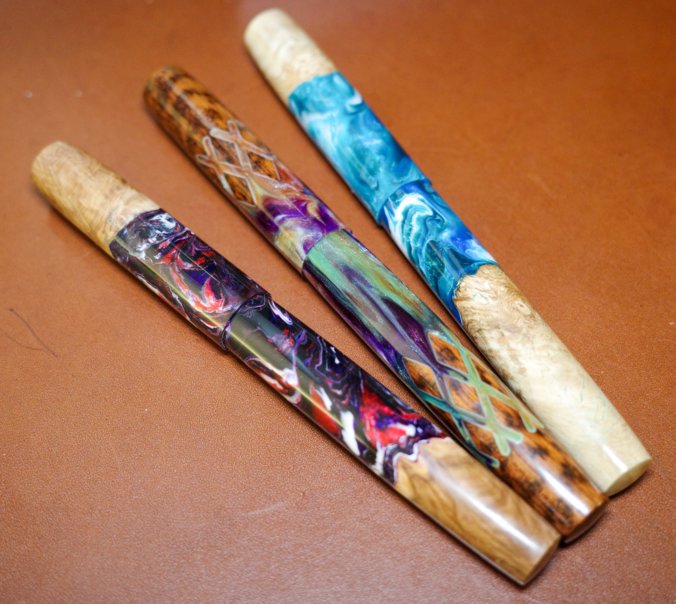I dunno about you, but my Facebook feed is absolutely swamped with people pouring epoxy resin on to pieces of wood. Often it’s a coffee table.

But you can also get phone cases and myrid other objects, large and small, made using this technique.
While this ‘hybrid’ effect is on the verge of being overdone, it’s easy to see what makes it popular. You get to show off the most interesting, twisted pieces of wood, combined with swirling colourful resin, looking like alien oceans.
Pen makers have adopted this technique too, and one I kept seeing in my feed was Silverburl Pens, a retired engineer called John Sanderson based in Cornwall. He’s hovering at about 500 followers so I figured I could do what I enjoy best, and spread the word. I approached him for a review sample and he was kind enough to send three my way.

I’ve been using them for a couple of months now, and after posting my first impressions video…
…it’s time for me to write up my final thoughts. Very little has changed.
One pen is Cornish driftwood, paired with turquoise and white.

One is Brown Mallee Burl, paired with red, purple, black and white.

One is Snakewood, interset with criss-cross resin in green and purple (not my cup of tea, but certainly creative).

Naturally all the resin is poured by John in-house, and while the cap and barrel are hybrid, the sections are turned from pure resin, so you can safely dip them in ink.

All three pens were turned by John to some rough specs I shared, are clipless, and are fitted with Bock #6 nibs, but I should note at this point that John has shown off a wide variety of models, including argentium silver clips and trim rings, JoWo or #8 nibs, and barrels of various sizes and shapes. He also does pens in all wood or all resin, and ebonite too. I just happened to opt for a pretty simple entry-level design, priced at £160 each.
So what’s good?
The cap threads are all triple start, and while not glassy smooth they work very reliably with no cross-threading. The caps spin off in a little over 1.5 turns. Thumbs up.
The section-to-barrel threads are also great, and that’s an area where some turners fall down. Getting access to the supplied converter is easy.

John’s section design is long and comfortable and all three pens feel very nice in the hand, with thick walls adding some weight.


The hybrid resin mixes are creative and colourful, and are clearly made with love.

The resin mates well with the wood with no bubbles or gaps, and the wood itself is carefully shaped with gentle domed ends and a soft satin finish.

Each of the three woods that John chose are beautifully grained and very different; the Mallee Burl is my particular favourite.

The polish on the resin parts is generally good, but not as mirror-finished as I’ve had from some makers.

I do have a few little issues with these pens, though.
Firstly: the resin seems to be quite soft, and a little brittle. The front edges of the cap threads have chipped off visibly on each pen (not during use — I noticed on day one).


Further, the cap lip flexes under even light pressure. The cap edges are very thin, which may contribute to the problem.


Even without overtightening the cap you can see a flaring of the lip where it meets the barrel when closed, particularly on the blue one, but also a little on the snakewood one. I wonder whether this is simply the nature of the resin mix, or something to do with the curing process.

Secondly: either the wood is absorbing moisture or the cap seal is not fully airtight, but whatever the cause I’ve found these pens dry out when left unused for a while. I didn’t notice that in my first impressions video that I embedded above, but in longer use it’s cropped up.
Thirdly: aesthetically, I find these pens attractive except for the very abrupt and pronounced step at the nib end of the section. I would have liked a more organic curve to match the materials and other elements of the silhouette.

Fourthly: while the section is long, the threads are a little sharp and there is a small step up to the barrel.
Fifthly: on each pen the lip of the cap is a little rough and unpolished. An easy fix.

And lastly, a note on nibs, because you’re probably wondering how these pens write. Normally, John tunes each of the nibs he uses in his pens — but for these review samples that he was rushing to me alongside his pre-Christmas trade, he asked if I’d mind him skipping that step. For me, I know how steel Bock nibs write, so I said no problem. And lo, I received three Bock nibs that each wrote less than well. We should all appreciate the work companies like Silverburl go to to make sure our nibs write out of the box, even in the face of shoddy work from Bock!
These pens are beautiful works of handicraft. I love the combination of wood and resin, and the gentle curves. I think with a few small fixes these could be wonderful pens, and I would have no hesitation in commissioning a pen in ebonite or other pen blank from John.

John sent me these three pens at no charge. You can order yours here. Or follow Silverburl pens on Instagram here.


Thank you for this, Anthony. I’ve often looked at John’s website and been very taken with his diamondcast pens, especially those with the lovely hand made silver clips. I’m less enamoured of these hybrid ones, but do feel I need to get a closer look…